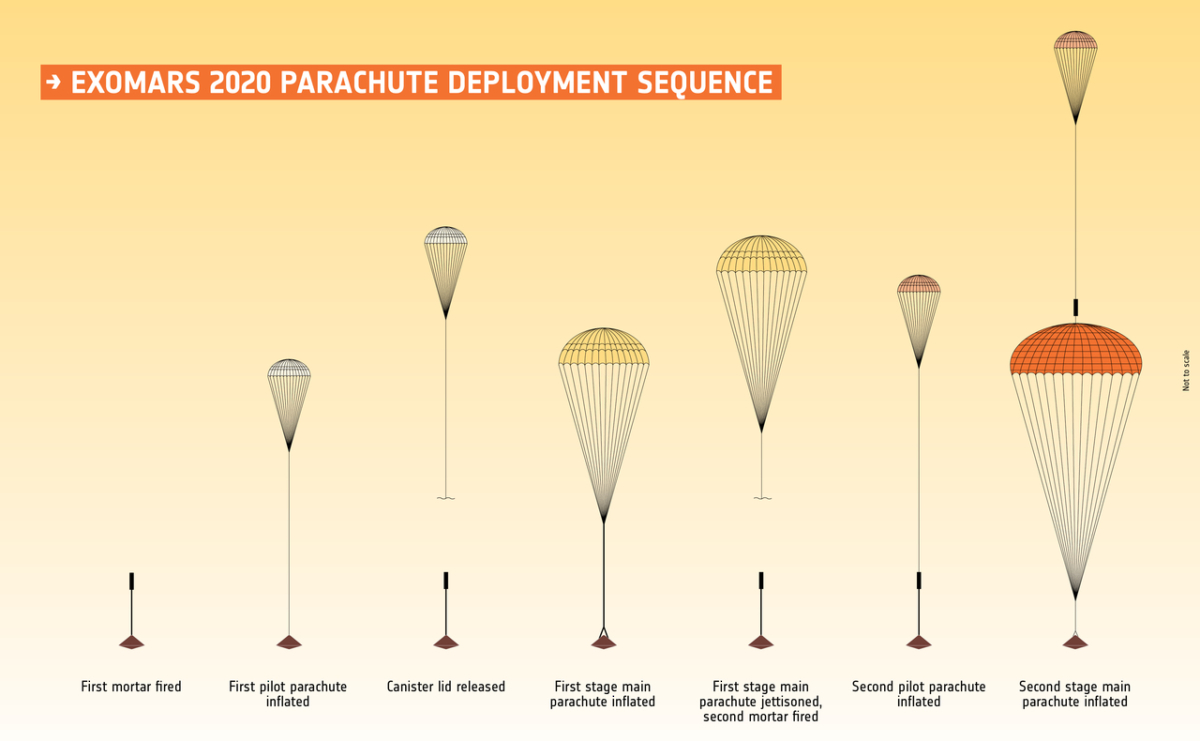
A life-hunting Mars mission will have to work fast if it wants to be ready for launch next summer.
Europe and Russia are working together to send a rover named Rosalind Franklin and a stationary lander called Kazachok toward the Red Planet in July 2020. The mission is the second part of the ExoMars program, which in 2016 launched the Trace Gas Orbiter (TGO) and the Schiaparelli landing demonstrator.
Schiaparelli crashed during its touchdown attempt in October 2016, and the ExoMars team is having some issues with the 2020 landing gear as well — specifically, the parachutes. (TGO made it to Mars orbit and is doing well.)
Related: How the European-Russian ExoMars Missions Work (Infographic)
The ExoMars 2020 mission will rely on two big parachutes to help slow its descent through the Red Planet's atmosphere — a 50-foot-wide (15 meters) main parachute and a 115-foot-wide (35 m) secondary one. (Each chute also has a pilot chute to help it deploy, so the system has a total of four parachutes.)
Both big chutes suffered damage during a high-altitude drop test in May of this year. Team members made some fixes, then performed another drop test of the 115-foot-wide parachute in early August. But the outcome was disappointingly similar: the chute suffered canopy damage again.
The ExoMars team has finished inspecting the recovered hardware from the August drop test, European Space Agency (ESA) officials said in a statement yesterday (Oct. 15). Such work will allow engineers to tweak the design of both big parachutes as well as the bags that contain them before deployment.
Get the Space.com Newsletter
Breaking space news, the latest updates on rocket launches, skywatching events and more!
ESA will also consult on parachute design with NASA, which has enjoyed a string of Mars-landing successes over the last decade and a half. The collaboration will allow the ExoMars team to use test equipment at NASA’s Jet Propulsion Laboratory in Pasadena, California, to help prove out the design tweaks ahead of the next planned high-altitude drop tests, which will take place between January and March in Oregon.
"ESA is working to complete the tests of both the 15-m and 35-m parachute prior to the ExoMars project’s 'qualification acceptance review,' which is planned for the end of April in order to meet the mission launch window (26 July-11 Aug 2020)," ESA officials wrote in the statement.
The team aims to integrate the certified parachute system into ExoMars 2020 before the spacecraft's April shipment to its launch site, Baikonur Cosmodrome in Kazakhstan, though this work could still be done at Baikonur in May, ESA officials added.
Either way, time is of the essence.
"This go/no go situation means it's a challenging time ahead for the mission — a race against the clock," the narrator said in an ESA ExoMars video update that was published yesterday.
The launch window is a hard deadline. If the ExoMars team misses it, the mission won't be able to lift off until 2022, because Earth and Mars align favorably for planetary missions just once every 26 months.
If ExoMars does meet the coming deadline, the mission will touch down on Mars in February 2021, likely in a region called Oxia Planum. This area, which exhibits plenty of evidence of liquid-water activity in the ancient past, is the recommended landing site for ExoMars 2020, though the exact location has not yet been firmed up.
Rosalind Franklin will hunt for signs of long-dead organisms, using a variety of science instruments and a drill that will allow the rover to access sediments 6.5 feet (2 meters) underground. Kazachok, meanwhile, will study the Martian atmosphere and weather and perform a number of other scientific investigations.
NASA has a life-hunting Mars rover of its own that's scheduled to launch in the 2020 window as well. The Mars 2020 craft, which will get a new name soon, will do its work inside Jezero Crater, which hosted a river delta billions of years ago.
- Red Planet Express: 10 Ways Robots Move on Mars
- ExoMars Rover Will Drill Deep Into Mars to Search for Life (Op-Ed)
- Robot Life on Mars! Meet the Machines Exploring the Red Planet Today
Mike Wall's book about the search for alien life, "Out There" (Grand Central Publishing, 2018; illustrated by Karl Tate), is out now. Follow him on Twitter @michaeldwall. Follow us on Twitter @Spacedotcom or Facebook.
Join our Space Forums to keep talking space on the latest missions, night sky and more! And if you have a news tip, correction or comment, let us know at: community@space.com.

Michael Wall is a Senior Space Writer with Space.com and joined the team in 2010. He primarily covers exoplanets, spaceflight and military space, but has been known to dabble in the space art beat. His book about the search for alien life, "Out There," was published on Nov. 13, 2018. Before becoming a science writer, Michael worked as a herpetologist and wildlife biologist. He has a Ph.D. in evolutionary biology from the University of Sydney, Australia, a bachelor's degree from the University of Arizona, and a graduate certificate in science writing from the University of California, Santa Cruz. To find out what his latest project is, you can follow Michael on Twitter.









